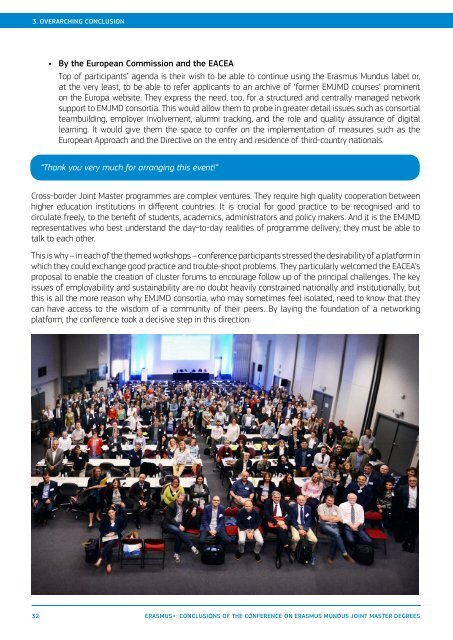Erasmus+
2kWLqbT
2kWLqbT
You also want an ePaper? Increase the reach of your titles
YUMPU automatically turns print PDFs into web optimized ePapers that Google loves.
3. OVERARCHING CONCLUSION<br />
ANNEX I. BRIEF OVERVIEW OF THE ERASMUS MUNDUS AND ERASMUS+: EMJMD PROGRAMMES<br />
• By the European Commission and the EACEA<br />
Top of participants’ agenda is their wish to be able to continue using the Erasmus Mundus label or,<br />
at the very least, to be able to refer applicants to an archive of ‘former EMJMD courses’ prominent<br />
on the Europa website. They express the need, too, for a structured and centrally managed network<br />
support to EMJMD consortia. This would allow them to probe in greater detail issues such as consortial<br />
teambuilding, employer involvement, alumni tracking, and the role and quality assurance of digital<br />
learning. It would give them the space to confer on the implementation of measures such as the<br />
European Approach and the Directive on the entry and residence of third-country nationals.<br />
“Thank you very much for arranging this event!”<br />
Cross-border Joint Master programmes are complex ventures. They require high quality cooperation between<br />
higher education institutions in different countries. It is crucial for good practice to be recognised and to<br />
circulate freely, to the benefit of students, academics, administrators and policy makers. And it is the EMJMD<br />
representatives who best understand the day-to-day realities of programme delivery; they must be able to<br />
talk to each other.<br />
This is why – in each of the themed workshops – conference participants stressed the desirability of a platform in<br />
which they could exchange good practice and trouble-shoot problems. They particularly welcomed the EACEA’s<br />
proposal to enable the creation of cluster forums to encourage follow up of the principal challenges. The key<br />
issues of employability and sustainability are no doubt heavily constrained nationally and institutionally, but<br />
this is all the more reason why EMJMD consortia, who may sometimes feel isolated, need to know that they<br />
can have access to the wisdom of a community of their peers. By laying the foundation of a networking<br />
platform, the conference took a decisive step in this direction.<br />
ANNEX I. BRIEF OVERVIEW OF THE ERASMUS<br />
MUNDUS AND ERASMUS+: EMJMD PROGRAMMES<br />
An EMMC/ EMJMD is a second-cycle integrated international study programme of 60, 90 or 120 ECTS credits.<br />
It is delivered by an international consortium of higher education institutions (HEIs) from several programme<br />
countries and from partner countries in all parts of the world 17 . Often the HEIs are joined by other educational<br />
and non-educational partners from Europe and beyond and count on the expertise of highly qualified scholars/<br />
guest lecturers. They award Master degrees which must be duly accredited. This can be either as a joint<br />
degree (i.e. a single diploma issued on behalf of at least two HEIs from different programme countries and<br />
duly accredited in those countries) or as multiple degrees (i.e. at least two diplomas issued by two duly<br />
accredited HEIs from different programme countries).<br />
An EMMC/EMJMD can exist in any academic discipline. It is characterised by its high degree of integration, as<br />
well by the excellence of its academic content and its learning and teaching methodology. The degrees are<br />
selected according to strict criteria, receive generous funding for three intakes of students and offer full degree<br />
scholarships to the best Master students worldwide.<br />
16 %<br />
14 %<br />
12 %<br />
10 %<br />
8 %<br />
6 %<br />
4 %<br />
2 %<br />
0 %<br />
EMMC and EMJMD Scholarship holders success rate<br />
2007-16<br />
2007 2008 2009 2010 2011 2012 2013 2014 2015 2016<br />
The courses selected display a high degree of ‘jointness’. This means a jointly designed and fully integrated<br />
academic curriculum, backed by collective implementation: e.g. joint student application, selection and<br />
admission procedures; joint assessment regulations; and shared quality assurance (QA) mechanisms. The<br />
concept of ‘jointness’ was one of the principal themes of the conference on ‘Mastering Joint Excellence’.<br />
The Erasmus Mundus programmes now span twelve years of continuing evolution and rising popularity. With<br />
sufficient numbers of institutions now engaged in the EMJMD programme, the European Higher Education<br />
Area (EHEA) is also a major beneficiary.<br />
EMJMD are distinguished by their academic excellence, the high level of integration of the courses between<br />
multiple higher education institutions across countries, and their internationalisation. 75% of the EMJMD<br />
scholarships budget fund partner country student scholarships, aiming to attract the best world students.<br />
17 Programme countries are the 28 Member States of the European Union, plus the former Yugoslav Republic of Macedonia, Iceland, Liechtenstein,<br />
Norway and Turkey. Participant third countries are known as partner countries. They are listed, by global region, on pages 23 and 24 of the 2016<br />
ERASMUS+ Programme Guide.<br />
32 ERASMUS+: CONCLUSIONS OF THE CONFERENCE ON ERASMUS MUNDUS JOINT MASTER DEGREES<br />
ERASMUS+: CONCLUSIONS OF THE CONFERENCE ON ERASMUS MUNDUS JOINT MASTER DEGREES<br />
33


